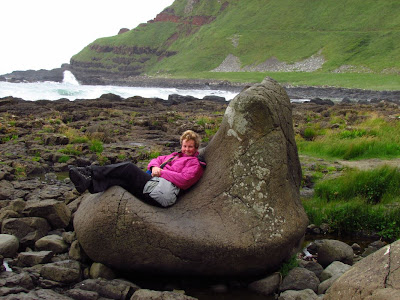Today we drove into Northern Ireland to follow the Giant Causeway Coastal Route. The first highlight was the Mussenden Temple a small circular building located on the cliffs near Castlerock in County Londonderry high above the Atlantic Ocean on the north western coast of Northern Island. It was built in 1785 and forms part of the estate of Frederick Augustus Hervey the 4th Earl of Bristol, Bishop of Derry. Built as a library and modelled from the Temple of Vesta in Italy.
The next place of interest was the Dunluce Castle located dramatically close to a headland that plunges straight into the sea, along the North Antrim Coast. Also the place of the sinking of a colony ship that broke up on the rocks off Islay in 1857 with the loss of 240 lives. The castle at the end of a narrow crossing to the rock formerly protected by a drawbridge to the gatehouse. The buildings on the rock are 16th & 17th century.
The Giants Causeway a UNESCO World Heritage Site is a geological wonder with over 40,000 interlocking basalt columns. The Giants Causeway is the result of intense volcanic and geological activity. It provides a glimpse into the Earth's most ancient past. An epic 60 million year old legacy to the cooling and shrinking of successive lava flows.
The Giants Causeway is steeped in myth and legend. Carved from the coast by the mighty giant Finn McCool who left behind an ancient home full of folklore. Local people here believe that between the hexagons, the mythical features carved out in the rocks and the tumbling sea, there's real magic. The myth tells that the causeway was built by an Irish giant named Finn McCool as a way to walk to Scotland in order to fight his Scottish nemesis, Bernandonner. The story goes that Finn fell asleep before he could cross to Scotland, and Bernandonner came across to Ireland looking for Finn. His wife, Oonaugh, upon seeing that the Scotsman was much larger than her husband, cleverly wrapped him up, and passed him off to Bernandonner as her baby. Upon seeing this enormous baby, the giant Scot, thinking that the father must indeed be a larger giant than he, went back to Scotland, tearing up the causeway as he went, to keep the giant Irishman from coming for him in Scotland. The legend made sense to people for many years, as there are similar formations across the water on the Scottish side.
We then stopped at White Park Bay to take in the view.
This amazing road of dark hedges was breathtaking. Bregagh Road Ballymoney has beech trees that were planted by the Stuart family in the eighteenth century. It was intended as a compiling landscape feature to impress visitors as they approached the entrance to their Georgian mansion, Gracehill House. Two centuries later, the trees remain a magnificent sight and have become one of the most photographed natural phenomena in Northern Ireland.
We stopped at Glenariff Forest Park to see the waterfall.
As we were passing through Belfast we saw the Stenaline Ferry coming in from mainland Britian the same line we travelled with to Dublin.
Views from Bernish Viewpoint on our way back home.
 |
| Giant Causeway Coastal Route |
 |
| View of Giants Causeway from Dunluce Castle |
 |
| The Wee Cottage across the road from the castle |
The Giants Causeway a UNESCO World Heritage Site is a geological wonder with over 40,000 interlocking basalt columns. The Giants Causeway is the result of intense volcanic and geological activity. It provides a glimpse into the Earth's most ancient past. An epic 60 million year old legacy to the cooling and shrinking of successive lava flows.
The Giants Causeway is steeped in myth and legend. Carved from the coast by the mighty giant Finn McCool who left behind an ancient home full of folklore. Local people here believe that between the hexagons, the mythical features carved out in the rocks and the tumbling sea, there's real magic. The myth tells that the causeway was built by an Irish giant named Finn McCool as a way to walk to Scotland in order to fight his Scottish nemesis, Bernandonner. The story goes that Finn fell asleep before he could cross to Scotland, and Bernandonner came across to Ireland looking for Finn. His wife, Oonaugh, upon seeing that the Scotsman was much larger than her husband, cleverly wrapped him up, and passed him off to Bernandonner as her baby. Upon seeing this enormous baby, the giant Scot, thinking that the father must indeed be a larger giant than he, went back to Scotland, tearing up the causeway as he went, to keep the giant Irishman from coming for him in Scotland. The legend made sense to people for many years, as there are similar formations across the water on the Scottish side.
 |
| Resting in the giants boot that fell off as he hurried away |
We then stopped at White Park Bay to take in the view.
This amazing road of dark hedges was breathtaking. Bregagh Road Ballymoney has beech trees that were planted by the Stuart family in the eighteenth century. It was intended as a compiling landscape feature to impress visitors as they approached the entrance to their Georgian mansion, Gracehill House. Two centuries later, the trees remain a magnificent sight and have become one of the most photographed natural phenomena in Northern Ireland.
We stopped at Glenariff Forest Park to see the waterfall.
As we were passing through Belfast we saw the Stenaline Ferry coming in from mainland Britian the same line we travelled with to Dublin.
Views from Bernish Viewpoint on our way back home.





























No comments:
Post a Comment